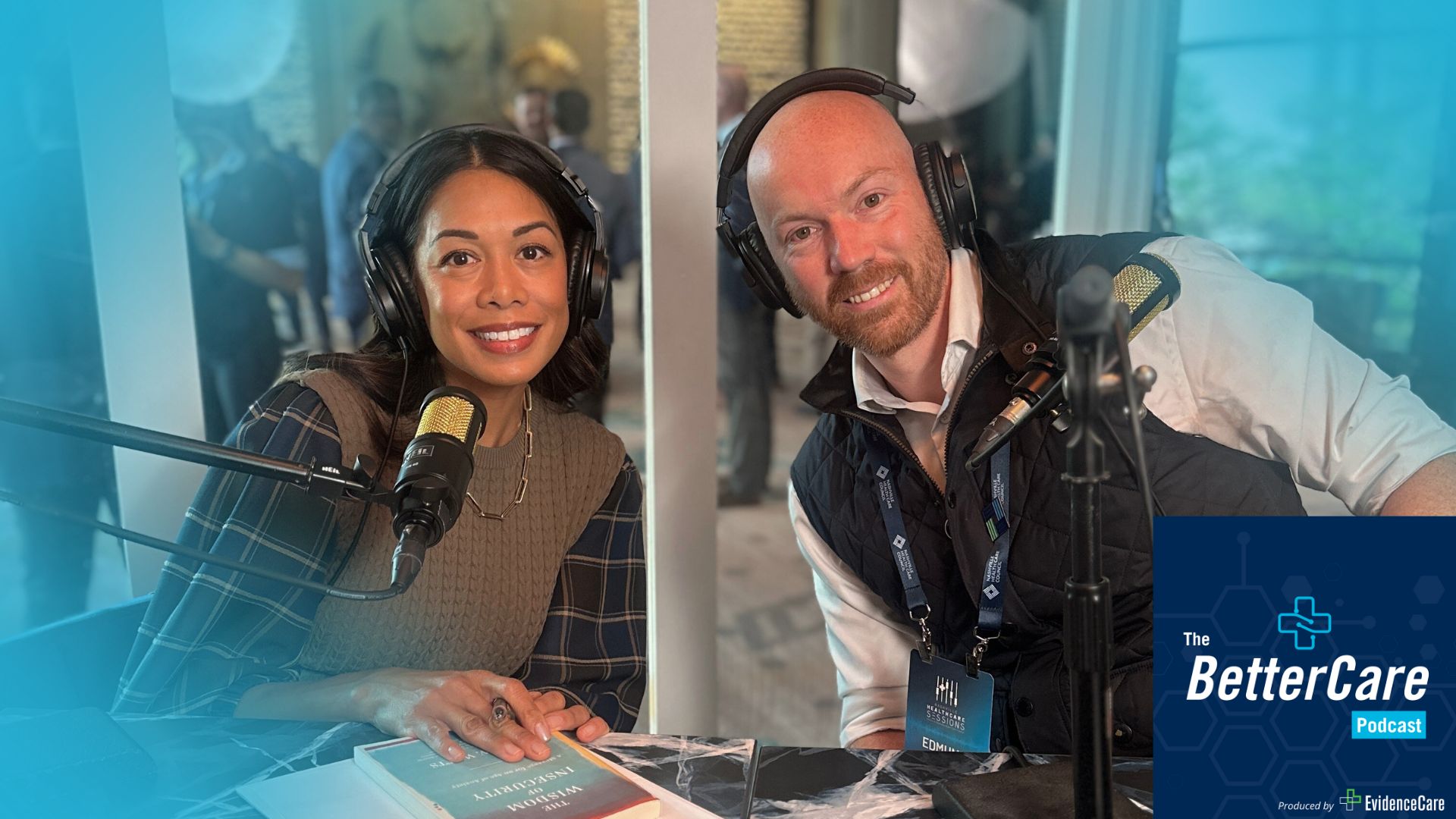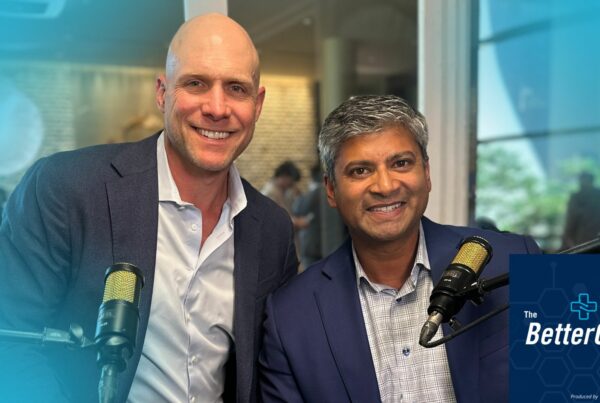Hospitals don’t need more AI hype. They need outcomes. In my conversation with UnityAI CEO, Dr. Edmund Jackson on The BetterCare Podcast, we explored where AI is dependable today (scribes, computer vision in radiology, voice and reasoning agents for scheduling), what still belongs in the lab, and how healthcare organizations can pilot agentic scheduling safely with governance, patient-first design, and low-risk use cases that improve access and revenue.
We recorded during Nashville Healthcare Sessions, a week when every hallway conversation seemed to include AI. Our aim was to cut through the noise and focus on what’s working in real healthcare operations, what is still experimental, and how leaders can create measurable value without boiling the ocean.
Some quotes have been lightly edited for clarity and brevity.
Ep 30 – Scaling Operational AI across Healthcare – Dr. Edmund Jackson (UnityAI)
Where AI is already delivering dependable value
1) Documentation and ambient scribing.
Drafting notes and required elements from clinician speech.
2) Computer vision in radiology.
Targeted, workflow-aware assistance that speeds reads and reduces miss risk.
3) Voice and reasoning agents for scheduling.
This is UnityAI’s focus. Edmund walked me through a typical patient interaction:
“What we do is we make an AI and it calls you and it says, ‘Hey Amy, you saw your orthopedic surgeon yesterday. She’s ordered an MRI of your knee. I’m calling from the radiology clinic. Can I get you in this week?’
‘No.’
‘How about next week? Nine o’clock? I’ll get you at Sunny Hills. Oh, you can’t make Sunny Hills? How about Misty Waters?’
It’ll have that conversation and schedule you. It’ll handle multiple schedules… so it gets you on the calendar.”
What’s different here isn’t the “chat.” It’s the booking.
“We don’t script it so much as give it goals and boundaries and parameters. ‘This is what the schedule looks like. This is what’s available. Your job as an AI is, in a friendly way, to schedule this patient.’ That’s very different from the IVR systems we’re used to.” – Dr. Edmund Jackson
Patients are accepting it more than you might expect:
“Less than ten percent of our calls end up being escalated to a live agent to be handled.”
And the team sweats details that matter for patient experience:
“We have so many details that need to be right. You know, things like how the AI reads a phone number. Teaching the AI that cadence so that it’s natural for the listener is the kind of thing we’re detailing out every single day.”
On disclosure, UnityAI leans transparent, to still let callers know they’re speaking with an AI agent.
4) RPM when paired with real workflow.
Devices alone are not enough. Devices plus escalation rules and coverage models are.
Governance that builds trust
We spent time on first principles, because that’s where AI projects succeed or fail.
“First rule for us is we don’t do anything clinical… We strictly stick into operations.”
“We’re very deliberate around having humans in the loop, at least in a management loop.”
“There’s a risk surface… so we do continual tests on all of these calls. Is it doing the right thing? Is the experience right?”
Said differently: start on the operations side (scheduling, navigation, outreach, benefits checks), monitor like a managed service, and keep your audit trail tight.
The right first use case (and why it matters)
If you need a fast, low-risk proof point with financial impact, Edmund recommends focusing on referral follow-up and appointment reminders:
“People think the quickest thing is the right place to start. It’s not. It’s the lowest-risk thing… In healthcare, the primary issue is risk.
We’ll work with a client where there’s a backlog of referrals. They’re usually unable to get to all of them in time. We’ll say, ‘You work your priority patients and give us the rest, and the AI will call those patients.’
It’s effectively free because you weren’t going to get there anyway. Then the AI can get them scheduled and move them through. If that isn’t the case, we’ll do things like referrals or reminders. Very low-risk things with very small technical integrations.”
This is not innovation theater. It’s a practical access play that should lift show rate, days-to-schedule, and referral close rate without adding FTEs.
What surprised me most
I went into this conversation thinking “AI for access” was primarily a staffing story. It still is, but what stuck with me is how much of it is a patient dignity story. When an agent reaches me quickly, knows my options, and gets me scheduled without bouncing me around, it respects my time. That’s not a shiny feature. That’s the healthcare experience we all say we want.
I also appreciated the simplicity of the mental model: give the agent clear goals and boundaries, then measure whether it did the job. Not “Can it talk like a human?” but “Did more patients get on the calendar sooner?” That shift—from novelty to outcome—is where I think hospitals will feel the real impact.
And the small experience details matter. The cadence of how a phone number is read. The tone on a reschedule. The clarity that it’s a virtual assistant with a quick path to a person. None of those headlines will grab attention on a conference stage, yet they’re exactly what builds trust at scale.
What I’m watching next
Three things I’ll be paying attention to as this space matures:
-
- Acceptance paired with transparency. Patients seem far more open to capable help than we assume, especially when we’re upfront about what the assistant is and offer an easy handoff to a person. I want to see more systems report those acceptance and escalation rates alongside access metrics.
- Agentic work beyond scheduling, but still operational. Scheduling is the obvious beachhead. The next wave I’m watching is navigation, pre-visit preparation, and benefits checks—still on the operations side, still measurable, still respectful of clinical boundaries.
- Leaders managing AI like a service line. Not a lab project. Not a one-off pilot. A managed, monitored service with sampling, SLAs, and clear ownership. In my world, that’s how you turn a promising tool into dependable capacity.
A simple takeaway
If there’s one lesson I’m carrying into planning, it’s this: scale outcomes, not hype. Start where risk is low and value is obvious. Keep the patient experience front and center. And evaluate AI by the most practical measure we have in access and ambulatory operations: more people getting the care they need, sooner.
If you want to watch the full conversation, watch the video above or listen to the episode of The BetterCare Podcast here.










